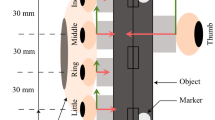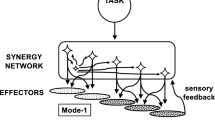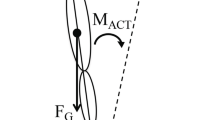Abstract
Although locomotion and prehension are commonly coordinated in everyday life, little previous research has focused on this form of coordination. To address this neglected topic, we asked participants to stand a variable distance from a table, walk up to the table, and move an object on the tabletop to a new tabletop position, either to the right or to the left of the object’s initial position and near or far from that initial position. For large manual displacements, which required a step after picking up the object, subjects preferred to stand on the foot opposite the direction of forthcoming manual displacement. By contrast, for small manual displacements, which did not require a step after picking up the object, subjects showed no support-leg preference when they grasped the object prior to manual displacement. The support-leg preferences at grasp time were apparently anticipated by participants as they walked up to the table, indicating considerable long-range planning of entire body positions associated with forthcoming object transfers.




Similar content being viewed by others
References
Bertram CP, Marteniuk RG, Wymer M (1999) Coordination during a combined locomotion/prehension task. J Sport Exerc Psychol 21:S18
Bertram CP, Marteniuk RG, Mackey DC (2000) Increasing upper limb task complexity leads to gait adaptations. Canadian Society for Psychomotor Learning and Sport Psychology: SCAPPS. Waterloo, p 47
Carnahan H, McFadyen BJ, Cockell DL, Halverson AH (1996) The combined control of locomotion and prehension. Neurosci Res Commun 19:91–100
Chaffin DB, Andersson GBJ, Martin BJ (1999) Occupational biomechanics, 3rd edn. Wiley Interscience Publications, New York, p 80
Cockell DL, Carnahan H, McFadyen BJ (1995) A preliminary analysis of the coordination of reaching, grasping, and walking. Percept Mot Skills 81:515–519
Cohen RG, Rosenbaum DA (2004) Where objects are grasped reveals how grasps are planned: generation and recall of motor plans. Exp Brain Res 157:486–495
Georgopoulos AP, Grillner S (1989) Visuomotor coordination in reaching and locomotion. Science 245:1209–1210
Grasso R, Zago M, Lacquaniti F (2000) Interactions between posture and locomotion: motor patterns in humans walking with bent versus erect posture. J Neurophysiol 83:288–300
Marteniuk RG, Bertram CP (2001) Contributions of gait and trunk movement to prehension: perspectives from world- and body-centered coordinates. Motor Control 5(2):151–164
Marteniuk RG, MacKenzie CL, Jeannerod M, Athenes S, Dugas C (1987) Constraints on human arm movement trajectories. Can J Psychol 4:365–378
Murray MP, Mollinger LA, Gardner GM, Sepic SB (1984) Kinematics and EMG patterns during slow, free, and fast walking. J Orthop Res 2:272–280
Oldfield RC (1971) The assessment and analysis of handedness: the Edinburgh inventory. Neuropsychologia 9:97–113
Patla AE, Ishac MG, Winter DA (2002) Anticipatory control of center of mass and joint stability during voluntary arm movements from a standing posture: interplay between active and passive control. Exp Brain Res 143:318–327
Rosenbaum DA, Meulenbroek RG, Vaughan J, Jansen C (2001) Posture-based motion planning: applications to grasping. Psychol Rev 108:709–734
Acknowledgments
The research was supported by grant SBR-94-96290 from the National Science Foundation, grants KO2-MH0097701A1 and R15 NS41887-01 from the National Institute of Mental Health, and the Research and Graduate Studies Office of The College of Liberal Arts, Pennsylvania State University.
Author information
Authors and Affiliations
Corresponding author
Additional information
This work is based on the Master’s thesis of the first author at the University of Maastricht, which was completed under the supervision of the second author while the first author spent an internship at the first author’s lab.
Rights and permissions
About this article
Cite this article
van der Wel, R.P.R.D., Rosenbaum, D.A. Coordination of locomotion and prehension. Exp Brain Res 176, 281–287 (2007). https://doi.org/10.1007/s00221-006-0618-0
Received:
Accepted:
Published:
Issue Date:
DOI: https://doi.org/10.1007/s00221-006-0618-0




